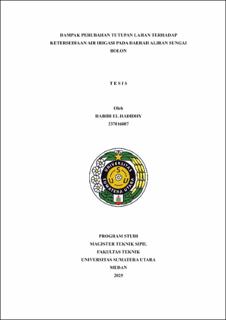| dc.description.abstract | Increasing food demand and urban development have driven rapid land cover change and affected water supply. Globally, irrigated agriculture is the largest consumer of water. This study aimed to assess the impact of land cover change on water supply in the Bolon watershed. Land cover change was analyzed using CA-MC method with QGIS plug in Molusce model and prediction of future land cover change. SWAT integration model with GIS was used to evaluate water supply. The results of image analysis during the 2017-2024 period revealed an increase in urban areas (4.8%), shrublands (1.0%) and water bodies (0.6%) and a decrease in forests (0.5%), irrigated agriculture (1.5%) and vegetations (4.5%) of the total area of the Bolon watershed. While in the period 2024-2033 showed an increase in urban areas (5.2%), vegetations (1.5%) irrigated agriculture (4.5%) and a decrease in forests (5.9%), shrublands (4.8%) and water bodies (0.5%) of the total area of the Bolon watershed. Modeling with SWAT+ resulted in monthly Q80 supply discharge with average discharge in 2017 (50.70 m3/s), 2024 (49.99 m3/s), 2029 (47,85 m3/s) and 2033 (47,27 m3/s). This study retrived that the impact of LULC changes on irrigation water supply at the sub-watershed scale during the 2017-2024 and 2024-2033 periods using SWAT+ is different from the result at the watershed scale. Land cover change of irrigated agriculture into urban areas, specifically in the downstream of the Bolon watershed during 2017-2033 period, caused a decrease in irrigation water demand so that the downstream watershed changes from low supply to medium supply and changes in vegetations land cover, and shrublands into urban areas in sub-watersheds during 2017-2033 period have caused a decrease in water supply in the river so that sub-watershed changes from high supply to medium supply. | en_US |


